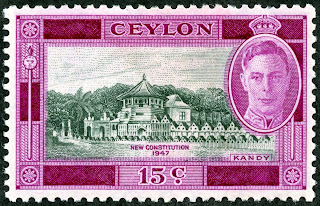Bud's Observations
Malaya’s stamps are mainly about cats and hats.
Not being endangered, hats are more prolific on stamps
and in Malaya’s marketplaces.
For classical
era Malaya, British stamp designers favored the likenesses of elaborately
behatted sultans. By comparison, British royalty usually appear unhatted on
colonial stamps with their crowns floating in the empyrean (India’s stamps
being an exception). Malayan chiefs rarely show up without hats or, more
properly, headdresses, since some of them are intricately folded cloths called
tengkoloks and some are Islamic-inspired songkok caps. Tengkoloks commonly represent
coffee leaves or flower fragments wrapped in such a way as to hide sultans’
secrets.
Malaya
male headgear
Sultan Ismail wins the prize for the most preposterous
hat on a stamp (Kelantan #38). “The hat makes the man.”
Not
a chef’s hat. Kelantan Sc #38
Sultans’ headdresses, arrayed in the album pages scanned
below, come in many varieties. I’ll trace out those worn by only one sultan -- Ibrahim Iskandar Al-Masyhur ibni Abu Bakar -- aka, in
stamp catalogs, as Sultan Ibrahim of Johore. Born in 1873, he died in 1959 in
London where he preferred to live. He ruled Johor for 64 years and, in the
process, developed a wild playboy reputation. His philatelic debut came with
the 1896-99 series issued on the occasion of his ascendancy, then, eight years
later, a second series featured a somewhat plumper Sultan sans moustache.
Sultan Ibrahim, Johore Sc #37
For both sittings, the Sultan wore a black
velvet songkok with a silver plumed aigrette which, along with a chest full of
medals, denoted his office. The songkok looks rather like an Ottoman fez, and
may have been introduced by Turkish sailors in the 19th century. Or,
as local lore suggests, it may trace back to the 13th century when
Islam came to Malaya.
Sultan Ibrahim, Johore Sc #67
The photo showing below may have
inspired the artist’s line drawing for Sc #67.
Sultan Ibrahim photo, circa 1904
In 1935 a single Johore stamp was issued
showing the Sultan, surprisingly, without headgear. He appears with his third
wife, the Scottish born Helen Ibrahim, nee Wilson. The stamp and a diamond were
wedding anniversary gifts for Her Highness, the Sultanah. They divorced three
years later. This and another Johore stamp issued in 1940 (Sc # 127) show the
only bare-headed sovereign ever to appear on Malayan postage, except, of
course, for British royalty on 1940s and 50s stamps (and the cats).
Johore, Sc #126
Returning to a hat but leaving his songkok aside, a
bespectacled Sultan dons a military beret for the 1949-55 series. On these
stamps, medals are comparatively understated
Johore Sc #s 131,135
And, near the end of his long tenure, he
wears a western-style bus driver’s hat and medals similar to if not identical
with the ones he wore in 1896.
Johore
Sc #156
Through it all, the other Malayan sultans continued to
wear traditional headgear.
Cat and hat together, 1957
Dr. Seuss would approve
Census: in BB spaces (column a), tip-in (column b), on
supplement pages (column c)
(a) (b)
(c)
Malaya-Fed. States 44 0 13
Johore 41 0 16
Kedah 24 1 9
Kelantan 31 0 4
Negri Sembilan 15 0 7
Pahang 13 0 1
Perak 37 0 11
Selangor 21 0 8
Sungei Ujong 6 0 0
Trengganu 25 0 13
The Malay Peninsula has been under British colonial and protectorate influence since Singapore became a crown colony in 1824. The Straits Settlements colony, consisting of Singapore, Malacca, and Penang, was formed in 1826. The rest of the Peninsula consisted of the sultanate led Malay States, under the administration and protection of the British. The blog post (link below) examines the stamps issued by the Malay States from 1876-1955.
Malaya & States Blog Post & BB Checklist
Page 1
1a
1b
1c
Page 2
2a
Page 3
3a
3b
3c
Page 4
4a
4b
4c
Page 5
5a
5b
5c
Page 6
6a
6b
6c
Page 7
7a
7b
7c
7d
Page 8
8a
8b
8c
8d
Supplements
Page 1
Page 2
Page 3
Page 4
Page 5
Page 6
Page 7
Comments appreciated!













































































